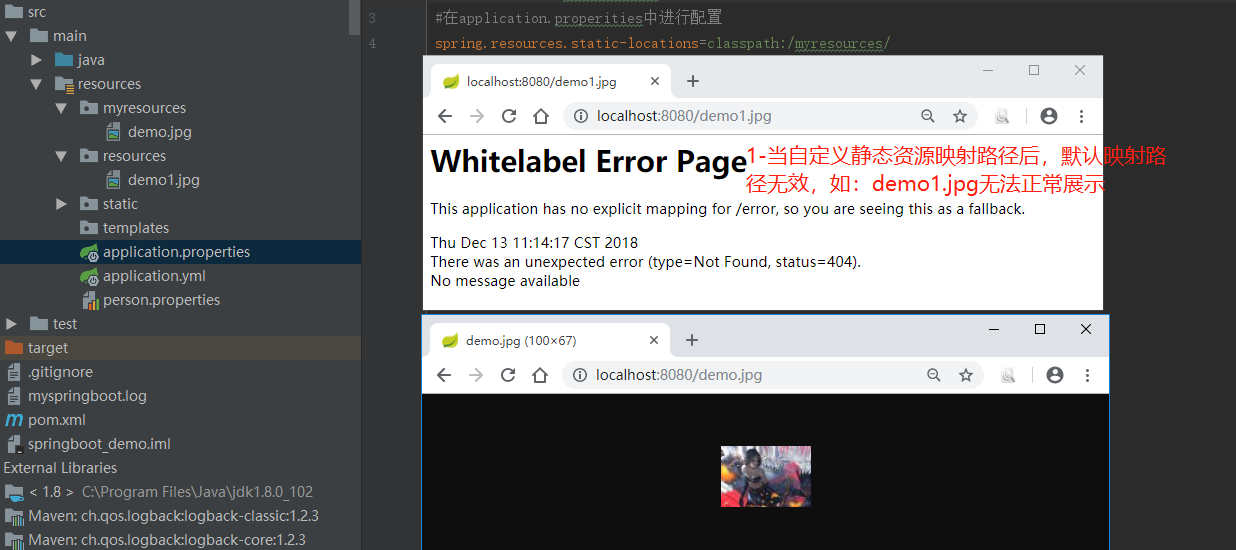SpringBoot學習-webjars和靜態資源對映規則
阿新 • • 發佈:2018-12-13
SpringBoot學習-webjars和靜態資源對映規則
前言
1-以前我們在IDEA中建立一個專案,新增web依賴包,我們現在是一個web應用,應該在man目錄下面有一個webapp資料夾,將所有的頁面都放在這裡,這是我們以前的做法。
2-現在我們建立的這個專案中,沒有這個webapp目錄,但是SpringBoot給我們做了規定。在SpringBoot中對SpringMVC的相關配置都在 WebMvcAutoConfiguration 這個類中做了規定。
3-本文主要內容
- /webjars/** ,在 classpath:/META-INF/resources/webjars/ 找資源
- "/**" 訪問當前專案的任何資源,都去(靜態資源的資料夾)找對映
- 歡迎頁; 靜態資原始檔夾下的所有index.html頁面;被"/**"對映;
- favicon.ico :所有的 **/favicon.ico 都是在靜態資原始檔下找;
正文
1-/webjars/** ,在 classpath:/META-INF/resources/webjars/ 找資源
1-1-原始碼分析
public static class WebMvcAutoConfigurationAdapter implements WebMvcConfigurer, ResourceLoaderAware {
1-2-webjars:以jar包的方式引入靜態資源,可以去http://www.webjars.org/ 這個網站選擇自己的靜態資源
1-2-1-去webjars官網獲取自己需要的maven依賴

1-2-2-將maven依賴匯入行pom.xml檔案

1-2-3-啟動專案,測試是否可以獲取jquery資源(示例路徑:http://localhost:8080/webjars/jquery/3.3.1/jquery.js)

2-自定義靜態檔案的對映路徑(意思為:我們把靜態檔案放在這些路徑下面,就會被載入到)
2-1-預設對映路徑:"classpath:/META-INF/resources/", "classpath:/resources/", "classpath:/static/", "classpath:/public/";優先順序順序為:META-INF/resources > resources > static > public
2-2-預設對映路徑,原始碼出處
//ResourceProperties類
@ConfigurationProperties(
prefix = "spring.resources",//如果要自己配置路徑,在配資字首為"spring.resources"
ignoreUnknownFields = false
)
public class ResourceProperties {
//聲明瞭預設classpath資源路徑為:{"classpath:/META-INF/resources/", "classpath:/resources/", "classpath:/static/", "classpath:/public/"}
private static final String[] CLASSPATH_RESOURCE_LOCATIONS = new String[]{"classpath:/META-INF/resources/", "classpath:/resources/", "classpath:/static/", "classpath:/public/"};
}
2-3-應用示例(http://localhost:8080/demo.jpg指的是依次去"classpath:/META-INF/resources/", "classpath:/resources/", "classpath:/static/", "classpath:/public/"去找demo.jpg圖片)

2-4-修改預設靜態資源路徑,方法一:配置spring.resources.static-locations引數
#在application.properities中進行配置,多個路徑可以用逗號隔開
spring.resources.static-locations=classpath:/myresources/

2-5-修改預設靜態資源路徑,方法二:重寫WebMvcConfigurerAdapter 中的addResourceHandlers方法,自定義對映路徑
2-5-1-重寫WebMvcConfigurerAdapter 中的addResourceHandlers方法,自定義對映路徑
@Configuration
public class MyWebMvcConfigurerAdapter extends WebMvcConfigurerAdapter {
/**
* 配置靜態訪問資源
* @param registry
*/
@Override
public void addResourceHandlers(ResourceHandlerRegistry registry) {
registry.addResourceHandler("/mypath/**").addResourceLocations("classpath:/myresources/");
super.addResourceHandlers(registry);
}
}
2-5-2-應用示例

3-歡迎頁面(當瀏覽器輸入專案路徑,無法匹配正確路徑,會去歡迎頁面)
3-1-原始碼分析
public static class WebMvcAutoConfigurationAdapter implements WebMvcConfigurer, ResourceLoaderAware {
private final ResourceProperties resourceProperties;
//1-指定this.getWelcomePage(),見2
@Bean
public WelcomePageHandlerMapping welcomePageHandlerMapping(ApplicationContext applicationContext) {
return new WelcomePageHandlerMapping(new TemplateAvailabilityProviders(applicationContext), applicationContext, this.getWelcomePage(), this.mvcProperties.getStaticPathPattern());
}
//2-去getIndexHtml()獲取歡迎頁面路徑,見3
private Optional<Resource> getWelcomePage() {
String[] locations = getResourceLocations(this.resourceProperties.getStaticLocations());
return Arrays.stream(locations).map(this::getIndexHtml).filter(this::isReadable).findFirst();
}
//3-預設歡迎頁面在location(對映路徑) + "index.html"
private Resource getIndexHtml(String location) {
return this.resourceLoader.getResource(location + "index.html");
}
}
3-2-應用示例

4-favicon.ico
4-1-所有的 **/favicon.ico 都是在靜態資原始檔下找
4-1-應用示例

參看資料:
1-https://blog.csdn.net/baidu_36216018/article/details/79699084
2-https://www.cnblogs.com/java-synchronized/p/7091723.html
3-https://blog.csdn.net/javareact/article/details/77981769
